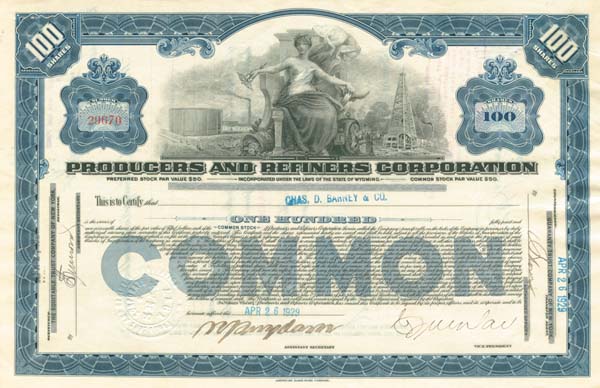Developing Wyoming petroleum riches…until the Great Depression.
The future of Wyoming’s young petroleum industry must have looked promising to the Producers and Refiners Corporation (PARCO) in the early 1920s.
Although oil had been discovered earlier, Wyoming’s first real drilling boom began north of Casper in 1908. “Initial development of Salt Creek oil field commenced in 1889 with the majority of primary development occurring between 1915 and 1930,” notes the U.S. Department of the Interior.

“Early records indicate that oil was found at depths as shallow as 22 feet in 1911,” the agency adds.
By 1930, about one-fifth of all oil produced in the United States came from Salt Creek. Read more in First Wyoming Oil Wells. PARCO built a refinery (and the town of Parco) in 1923 in south central Wyoming. It was near Rawlins and the continental divide, about 6,700 feet in elevation.
Sinclair Oil
Meanwhile, Consolidated Oil Company (renamed Sinclair Oil Corporation in 1943) annexed the assets of the Prairie Pipeline and its producing companies. The deal was for stock valued at $136 million.

The Salt Creek oil field boom began in 1889 continued through 1930. This is an Atlantic and Pacific Oil Company well circa 1903. Photo courtesy Wyoming State Archives.
The 1932 acquisition gave Sinclair the largest pipeline system in America. It also helped bring an end to PARCO. Part of the purchase included about $13 million in debt and loan guarantees that Prairie Pipeline had committed to PARCO, which went into receivership within a month of the acquisition.
Sinclair bought the bankrupt company’s assets at auction in 1934.
PARCO went bankrupt – along with many other oil companies when oil prices plummeted and the Great Depression arrived. As a result, Sinclair had to pay PARCO debts, including those for the refinery 120 miles southwest of Casper.

Producers and Refiners Corporation, which built a Wyoming refinery in 1923, did not survive the Great Depression.
“In its production policy, Sinclair was far ahead of the industry,” notes a Sinclair historian. “Most producers and refiners belched out their daily capacities with no heed to the laws of supply and demand,” he added. “Over supply and over production caused several severe oil industry depressions during years of general business prosperity.”
Common stock shareholders of PARCO were left with worthless securities and today have value only to collectors. Other companies experienced similar fates during Wyoming’s petroleum boom and bust cycle.
“Buffalo Bill” Cody’s legacy extends beyond his wild west show. A Wyoming town named for him preserves his Big Horn Basin heritage – and his brief exploration into the oil business. Learn more in Buffalo Bill Shoshone Oil Company.
The Wyoming town of Sinclair – formerly known as Parco – includes a community museum with exhibits about the region’s history. Six miles east is Benton, a ghost town that was once a terminal for the Union Pacific Railroad.
Founded by Harry F. Sinclair in 1916, Sinclair Oil is one of the oldest continuous names in the oil industry. Learn more in Dinosaur Fever – Sinclair’s Icon. According to the company, its Sinclair refinery today ranks among the largest high conversion facilities in the Rocky Mountain region, with technologies allowing it to process, “a diverse crude slate, including heavy sour Canadian crude and indigenous Utah Waxy crude.”
The Sinclair plant processes oil at a rate in excess of 80,000 barrels per day. The company assisted in construction of a pipeline to transport gasoline and diesel fuel from Salt Lake City to Cedar City and Las Vegas, Nevada. Sinclair also operates a refinery in Casper that started operations as the White Eagle Refinery in 1923. It remains one of the oldest refineries still operating in the Rocky Mountains.
__________________
The stories of exploration and production companies joining petroleum booms (and avoiding busts) can be found updated in Is my Old Oil Stock worth Anything? The American Oil & Gas Historical Society preserves U.S. petroleum history. Please support this energy education website. For more information, contact bawells@aoghs.org. Copyright © 2002-2020, Bruce A. Wells. All rights reserved.

